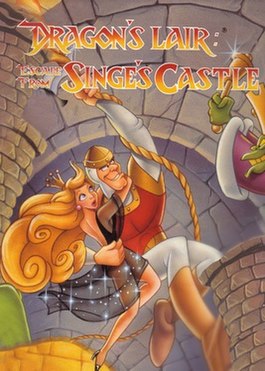Escape from Singe's Castle
| Escape from Singe's Castle | |
|---|---|
 Cover art for the 8-bit version | |
| Publisher(s) | Software Projects (8 bit, Europe), Electronic Arts (Commodore 64, USA), Readysoft (16 bit) |
| Series | Dragon's Lair |
| Platform(s) | Amstrad CPC, Commodore 64, ZX Spectrum, Amiga, Atari ST, MS-DOS, Mac OS |
| Release | 1987 (8-bit) 1991 (16-bit) |
| Mode(s) | Single-player |
Escape from Singe's Castle, also known as Dragon's Lair Part II - Escape From Singe's Castle, is a computer game for the Amstrad CPC, Commodore 64 and ZX Spectrum home computers. Later, Readysoft made the Amiga, Atari ST versions. The PC version was developed by Bethesda Softworks.[1][2] The game is sometimes referred to as Dragon's Lair II, but is different than the official arcade sequel Dragon's Lair II: Time Warp. It was released in 1987 by Software Projects.
Gameplay[]
Players control Dirk the Daring, the player character from Dragon's Lair, who has returned to the lair of Singe the dragon in order to claim a pot of gold (to save Daphne again in the 16 bit version). Singe has laid traps throughout his lair, forcing players to guide Dirk across a number of differently themed screens in order to steal the gold and escape.[3] In the 8 bit versions there are eight different levels.
Development[]
Software Projects had licensed the Coleco Adam version of Dragon's Lair to be released on 8-bit home computers, but due to the limitations of memory size and media space very few scenes could be contained in the conversion. Therefore, a second game entitled Escape from Singe's Castle was created to contain some of the missing scenes. Some retained the original control method of only allowing a directional movement at the right time. Other sections had a smaller, more controllable Dirk.
The Commodore 64 cassette version features the same loading system as the original Dragon's Lair conversion - the next game level loads while the player attempts the current level.
The Amiga version had a hard disk install option that supported the first Dragon's Lair conversion; a user that owned the first and second games could install scenes from both, resulting in a single bigger game. The American Commodore 64 version had a two-sided disk, with the first Dragon's Lair on the other side of the disk (however, the front cover only showed the name Dragon's Lair).
Reception[]
Allen L. Greenberg reviewed the game for Computer Gaming World, and stated that "Dragon's Lair II: Escape From Singe's Castle is an odd creature, an exceptional program which suffers from uninteresting game-play."[4]
References[]
- ^ "Bethesda A brief History". GamePro. p. 71. Retrieved July 12, 2021.
- ^ "Bethesda Softworks History". bethsoft.com. Archived from the original on June 5, 1997. Retrieved December 12, 2021.
- ^ Walker, Andy (April 1987). "Reviews - Escape From Singe's Castle - Dragon's Lair II". Crash. No. 39. Newsfield Publications Ltd. p. 120. Retrieved 2016-04-23.
- ^ Greenberg, Allen L. (March 1992). "As the Worm Turns - ReadySoft's Dragon's Lair II: Escape from Singe's Castle". Computer Gaming World. 1 (92): 74.
External links[]
- 1987 video games
- Amiga games
- Amstrad CPC games
- Atari ST games
- Commodore 64 games
- DOS games
- Dragon's Lair
- Classic Mac OS games
- Video games developed in the United Kingdom
- ZX Spectrum games